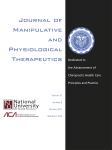
Physical Therapy & Rehab
Effect of HVLA vs. sham on vertical jump in athletes with talocrural joint dysfunction
J Manipulative Physiol Ther. 2014 Feb;37(2):116-23. doi: 10.1016/j.jmpt.2013.11.004. Epub 2014 Jan 222 female elite-level handball athletes with talocrural joint dysfunction were randomized to undergo high-velocity, low-amplitude (HVLA) manipulation to either the talocrural joint (active treatment) or the distal tibia (sham treatment). The purpose of this pilot study was to determine the feasibility of trial comparing these two interventions with respect to improvements in vertical jump height. Results indicated that a full-scale randomized control trial comparing active HVLA manipulation of the talocrural joint and a sham intervention is feasible, and there is some indication the active intervention may have positive effects on vertical jump height in this population. The number of patients required in this type of trial is 199 per study arm.
Unlock the full article
Get unlimited access to OrthoEvidence with a free trial
Start TrialCritical appraisals of the latest, high-impact randomized controlled trials and systematic reviews in orthopaedics
Access to OrthoEvidence podcast content, including collaborations with the Journal of Bone and Joint Surgery, interviews with internationally recognized surgeons, and roundtable discussions on orthopaedic news and topics
Subscription to The Pulse, a twice-weekly evidence-based newsletter designed to help you make better clinical decisions
Exclusive access to original content articles, including in-house systematic reviews, and articles on health research methods and hot orthopaedic topics
Or continue reading this full article
Register Now

Subscribe to "The Pulse"
Evidence-Based Orthopaedics direct to your inbox.




































